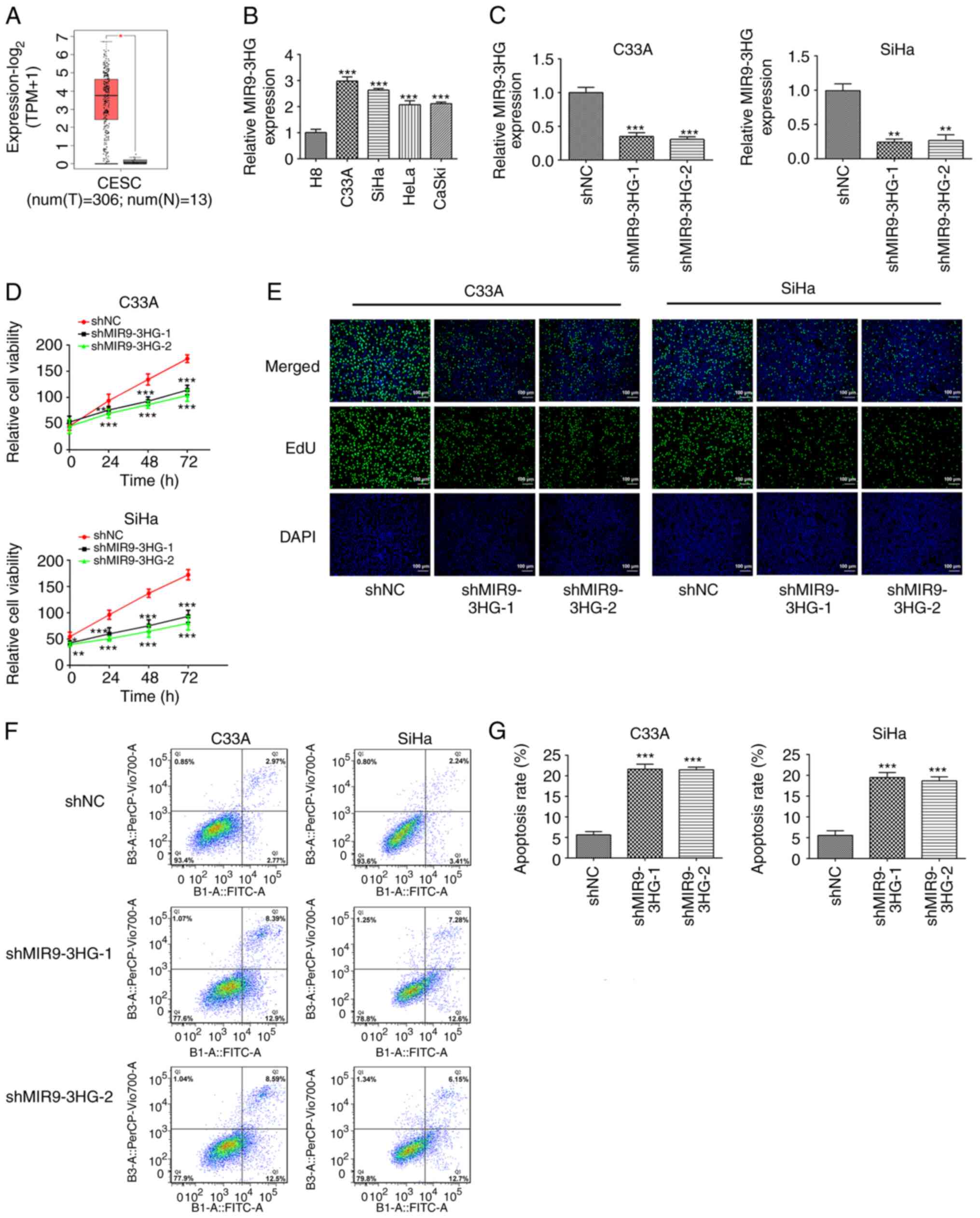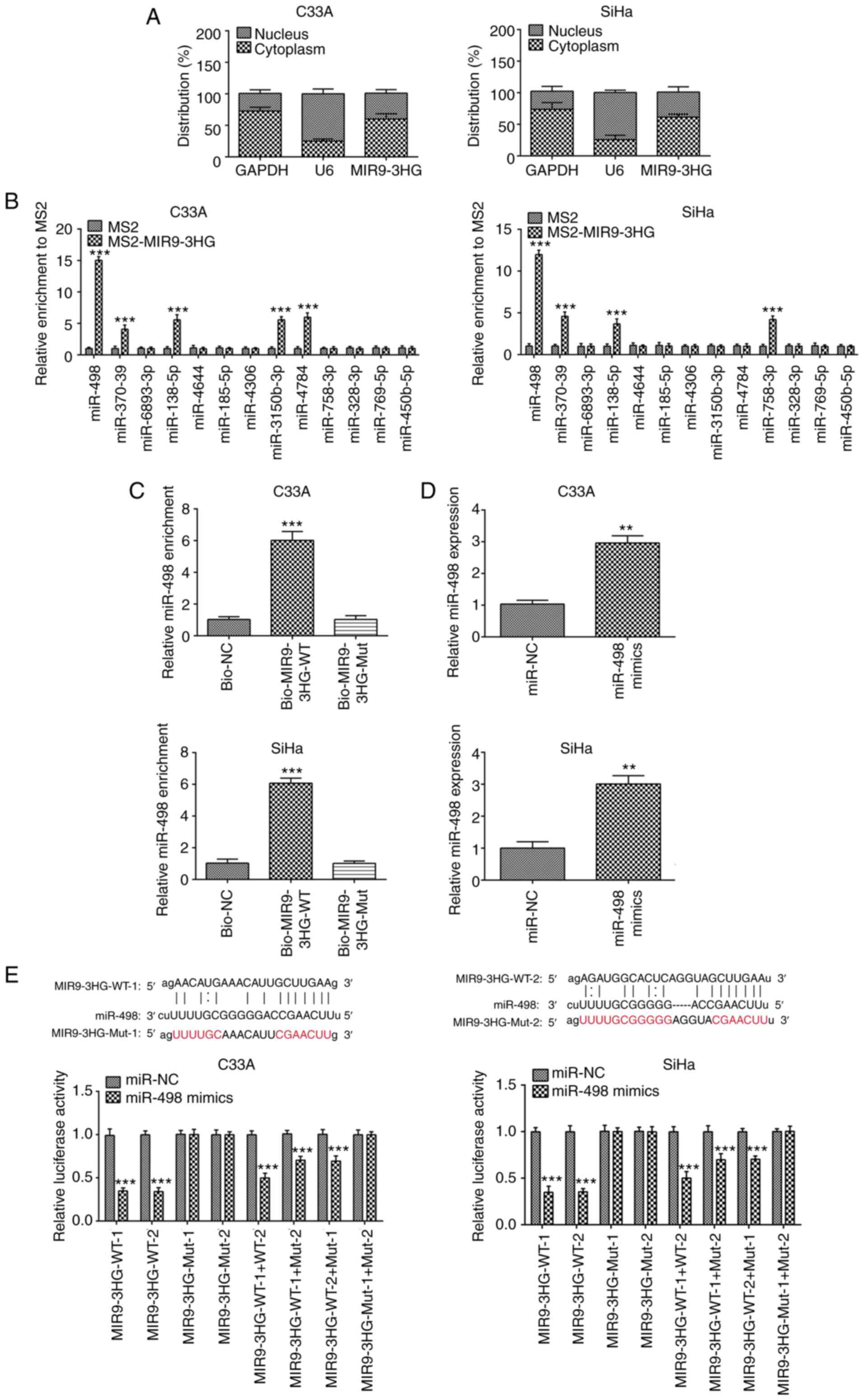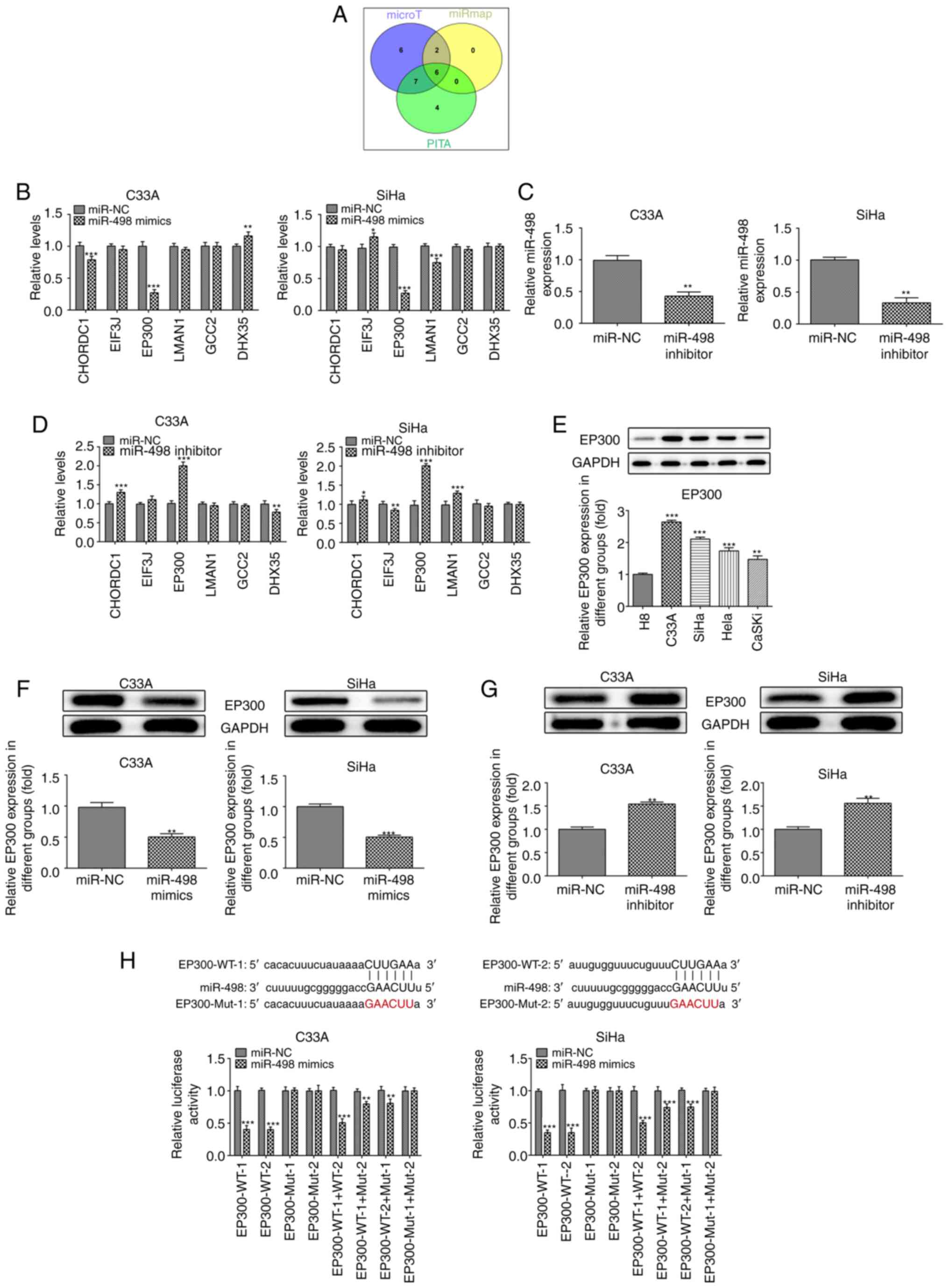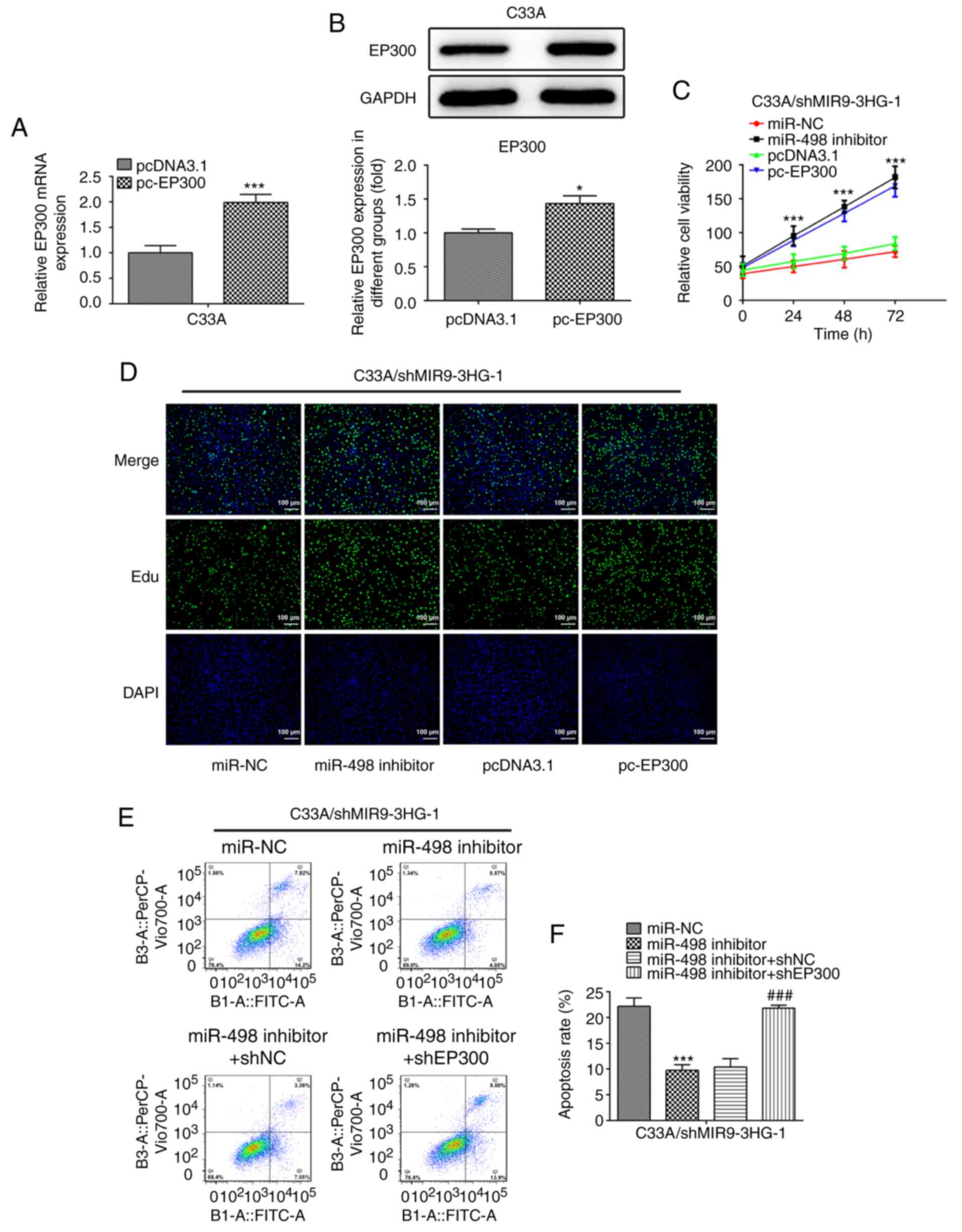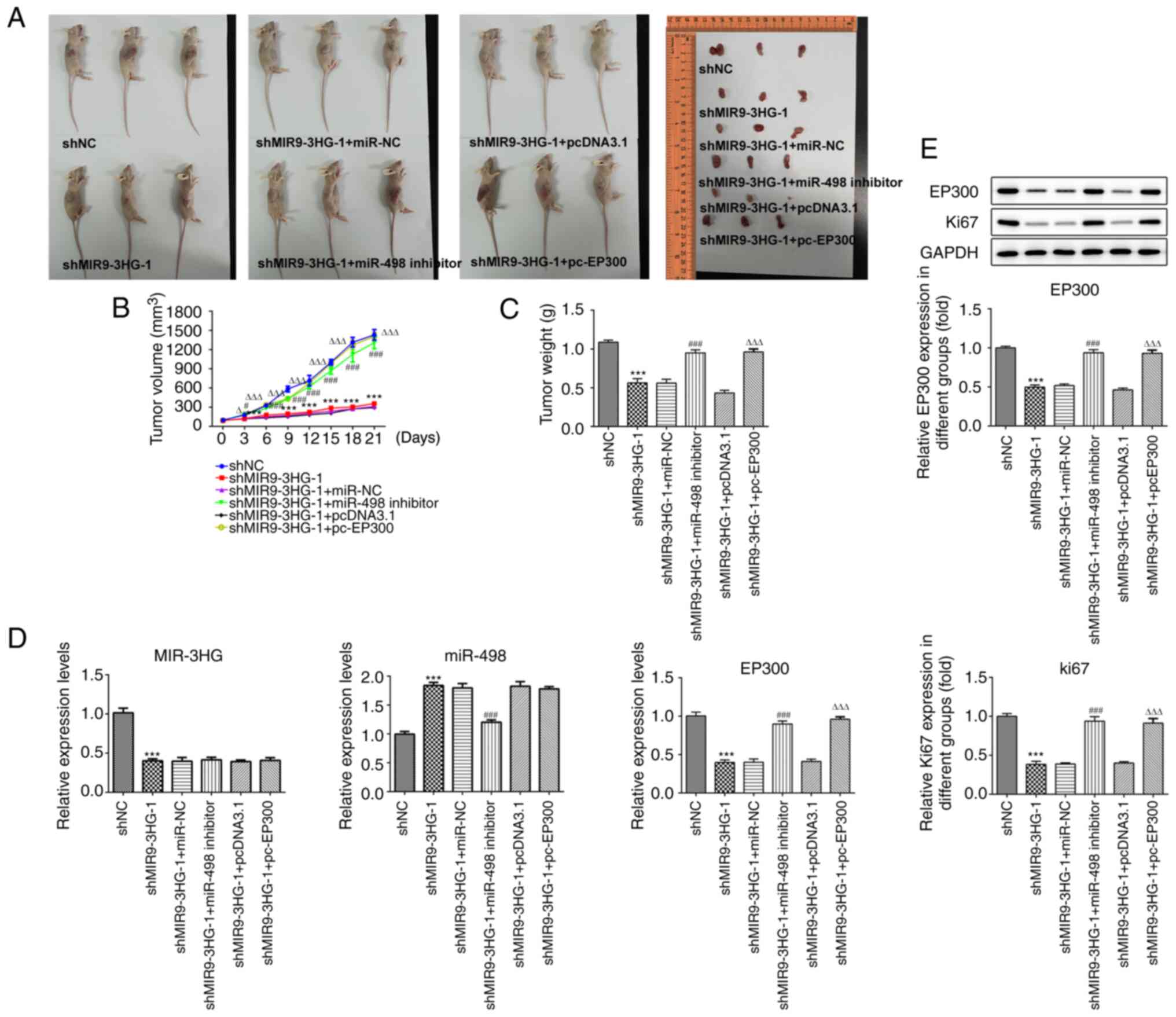|
1
|
Bouvard V, Zaitchouk T, Vacher M, Duthu A,
Canivet M, Choisy-Rossi C, Nieruchalski M and May E: Tissue and
cell-specific expression of the p53-target genes: Bax, fas, mdm2
and waf1/p21, before and following ionising irradiation in mice.
Oncogene. 19:649–660. 2000. View Article : Google Scholar : PubMed/NCBI
|
|
2
|
Yang L, Yi K, Wang H, Zhao Y and Xi M:
Comprehensive analysis of lncRNAs microarray profile and
mRNA-lncRNA co-expression in oncogenic HPV-positive cervical cancer
cell lines. Oncotarget. 7:49917–49929. 2016. View Article : Google Scholar : PubMed/NCBI
|
|
3
|
Naga Ch P, Gurram L, Chopra S and
Mahantshetty U: The management of locally advanced cervical cancer.
Curr Opin Oncol. 30:323–329. 2018. View Article : Google Scholar : PubMed/NCBI
|
|
4
|
Klingenberg M, Matsuda A, Diederichs S and
Patel T: Non-coding RNA in hepatocellular carcinoma: Mechanisms,
biomarkers and therapeutic targets. J Hepatol. 67:603–618. 2017.
View Article : Google Scholar : PubMed/NCBI
|
|
5
|
Zhang K, Han Y, Hu Z, Zhang Z, Shao S, Yao
Q, Zheng L, Wang J, Han X, Zhang Y, et al: SCARNA10, a
nuclear-retained long non-coding RNA, promotes liver fibrosis and
serves as a potential biomarker. Theranostics. 9:3622–3638. 2019.
View Article : Google Scholar : PubMed/NCBI
|
|
6
|
Lang HL, Hu GW, Zhang B, Kuang W, Chen Y,
Wu L and Xu GH: Glioma cells enhance angiogenesis and inhibit
endothelial cell apoptosis through the release of exosomes that
contain long non-coding RNA CCAT2. Oncol Rep. 38:785–798. 2017.
View Article : Google Scholar : PubMed/NCBI
|
|
7
|
Sandiford OA, Moore CA, Du J, Boulad M,
Gergues M, Eltouky H and Rameshwar P: Human Aging and Cancer: Role
of miRNA in Tumor Microenvironment. Adv Exp Med Biol. 1056:137–152.
2018. View Article : Google Scholar : PubMed/NCBI
|
|
8
|
Van Roosbroeck K and Calin GA: Cancer
Hallmarks and MicroRNAs: The Therapeutic Connection. Adv Cancer
Res. 135:119–149. 2017. View Article : Google Scholar : PubMed/NCBI
|
|
9
|
López-Urrutia E, Bustamante Montes LP,
Ladrón de Guevara Cervantes D, Pérez-Plasencia C and Campos-Parra
AD: Crosstalk Between Long Non-coding RNAs, Micro-RNAs and mRNAs:
Deciphering Molecular Mechanisms of Master Regulators in Cancer.
Front Oncol. 9:6692019. View Article : Google Scholar : PubMed/NCBI
|
|
10
|
Wang JY, Yang Y, Ma Y, Wang F, Xue A, Zhu
J, Yang H, Chen Q, Chen M, Ye L, et al: Potential regulatory role
of lncRNA-miRNA-mRNA axis in osteosarcoma. Biomed Pharmacother.
121:1096272020. View Article : Google Scholar : PubMed/NCBI
|
|
11
|
Zhang B, Yu L, Han N, Hu Z, Wang S, Ding L
and Jiang J: LINC01116 targets miR-520a-3p and affects IL6R to
promote the proliferation and migration of osteosarcoma cells
through the Jak-stat signaling pathway. Biomed Pharmacother.
107:270–282. 2018. View Article : Google Scholar : PubMed/NCBI
|
|
12
|
Wu WJ, Shen Y, Sui J, Li CY, Yang S, Xu
SY, Zhang M, Yin LH, Pu YP and Liang GY: Integrated analysis of
long non coding RNA competing interactions revealed potential
biomarkers in cervical cancer: Based on a public database. Mol Med
Rep. 17:7845–7858. 2018.PubMed/NCBI
|
|
13
|
Hu Y, Guo G, Li J, Chen J and Tan P:
Screening key lncRNAs with diagnostic and prognostic value for head
and neck squamous cell carcinoma based on machine learning and
mRNA-lncRNA co-expression network analysis. Cancer Biomark.
27:195–206. 2020. View Article : Google Scholar : PubMed/NCBI
|
|
14
|
Livak KJ and Schmittgen TD: Analysis of
relative gene expression data using real-time quantitative PCR and
the 2(−Δ Δ C(T)) Method. Methods. 25:402–408. 2001. View Article : Google Scholar : PubMed/NCBI
|
|
15
|
Jemal A, Bray F, Center MM, Ferlay J, Ward
E and Forman D: Global cancer statistics. CA Cancer J Clin.
61:69–90. 2011. View Article : Google Scholar : PubMed/NCBI
|
|
16
|
Lee YY, Choi CH, Kim TJ, Lee JW, Kim BG,
Lee JH and Bae DS: A comparison of pure adenocarcinoma and squamous
cell carcinoma of the cervix after radical hysterectomy in stage
IB-IIA. Gynecol Oncol. 120:439–443. 2011. View Article : Google Scholar : PubMed/NCBI
|
|
17
|
Park JY, Kim DY, Kim JH, Kim YM, Kim YT
and Nam JH: Outcomes after radical hysterectomy in patients with
early-stage adenocarcinoma of uterine cervix. Br J Cancer.
102:1692–1698. 2010. View Article : Google Scholar : PubMed/NCBI
|
|
18
|
Gupta S, Kumar P and Das BC: HPV:
Molecular pathways and targets. Curr Probl Cancer. 42:161–174.
2018. View Article : Google Scholar : PubMed/NCBI
|
|
19
|
Huang HW, Xie H, Ma X, Zhao F and Gao Y:
Upregulation of lncRNA PANDAR predicts poor prognosis and promotes
cell proliferation in cervical cancer. Eur Rev Med Pharmacol Sci.
21:4529–4535. 2017.PubMed/NCBI
|
|
20
|
Zhao LP, Li RH, Han DM, Zhang XQ, Nian GX,
Wu MX, Feng Y, Zhang L and Sun ZG: Independent prognostic Factor of
low-expressed lncRNA ZNF667-AS1 for cervical cancer and inhibitory
function on the proliferation of cervical cancer. Eur Rev Med
Pharmacol Sci. 21:5353–5360. 2017.PubMed/NCBI
|
|
21
|
Yao RW, Wang Y and Chen LL: Cellular
functions of long noncoding RNAs. Nat Cell Biol. 21:542–551. 2019.
View Article : Google Scholar : PubMed/NCBI
|
|
22
|
Katsushima K, Natsume A, Ohka F, Shinjo K,
Hatanaka A, Ichimura N, Sato S, Takahashi S, Kimura H, Totoki Y, et
al: Targeting the Notch-regulated non-coding RNA TUG1 for glioma
treatment. Nat Commun. 7:136162016. View Article : Google Scholar : PubMed/NCBI
|
|
23
|
Li W and Jiang H: Up-regulation of miR-498
inhibits cell proliferation, invasion and migration of
hepatocellular carcinoma by targeting FOXO3. Clin Res Hepatol
Gastroenterol. 44:29–37. 2020. View Article : Google Scholar : PubMed/NCBI
|
|
24
|
Lu M, Liu B, Xiong H, Wu F, Hu C and Liu
P: Trans−3,5,4´-trimethoxystilbene reduced gefitinib
resistance in NSCLCs via suppressing MAPK/Akt/Bcl-2 pathway by
upregulation of miR-345 and miR-498. J Cell Mol Med. 23:2431–2441.
2019. View Article : Google Scholar : PubMed/NCBI
|
|
25
|
Zhang X, Xu X, Ge G, Zang X, Shao M, Zou
S, Zhang Y, Mao Z, Zhang J, Mao F, et al: miR 498 inhibits the
growth and metastasis of liver cancer by targeting ZEB2. Oncol Rep.
41:1638–1648. 2019.PubMed/NCBI
|
|
26
|
Chai Q, Zheng M, Wang L, Wei M, Yin Y, Ma
F, Li X, Zhang H and Liu G: Circ_0068655 Promotes Cardiomyocyte
Apoptosis via miR-498/PAWR Axis. Tissue Eng Regen Med. 17:659–670.
2020. View Article : Google Scholar : PubMed/NCBI
|
|
27
|
Li G, Tan W, Fang Y, Wu X, Zhou W, Zhang
C, Zhang Y, Liu Y, Jiu G and Liu D: circFADS2 protects LPS-treated
chondrocytes from apoptosis acting as an interceptor of
miR-498/mTOR cross-talking. Aging (Albany NY). 11:3348–3361. 2019.
View Article : Google Scholar : PubMed/NCBI
|
|
28
|
Rong X, Gao W, Yang X and Guo J:
Downregulation of hsa_circ_0007534 restricts the proliferation and
invasion of cervical cancer through regulating miR-498/BMI-1
signaling. Life Sci. 235:1167852019. View Article : Google Scholar : PubMed/NCBI
|
|
29
|
Zhao F, Han Y, Liu Z, Zhao Z, Li Z and Jia
K: circFADS2 regulates lung cancer cells proliferation and invasion
via acting as a sponge of miR-498. Biosci Rep. 38:382018.
View Article : Google Scholar
|
|
30
|
Duan XM, Liu XN, Li YX, Cao YQ, Silayiding
A, Zhang RK and Wang JP: MicroRNA-498 promotes proliferation,
migration, and invasion of prostate cancer cells and decreases
radiation sensitivity by targeting PTEN. Kaohsiung J Med Sci.
35:659–671. 2019. View Article : Google Scholar : PubMed/NCBI
|
|
31
|
Liu R, Liu F, Li L, Sun M and Chen K:
miR-498 regulated FOXO3 expression and inhibited the proliferation
of human ovarian cancer cells. Biomed Pharmacother. 72:52–57. 2015.
View Article : Google Scholar : PubMed/NCBI
|
|
32
|
Wang Y, Li Y, He H and Wang F: Circular
RNA circ-PRMT5 facilitates non-small cell lung cancer proliferation
through upregulating EZH2 via sponging miR-377/382/498. Gene.
720:1440992019. View Article : Google Scholar : PubMed/NCBI
|
|
33
|
Asaduzzaman M, Constantinou S, Min H,
Gallon J, Lin ML, Singh P, Raguz S, Ali S, Shousha S, Coombes RC,
et al: Tumour suppressor EP300, a modulator of paclitaxel
resistance and stemness, is downregulated in metaplastic breast
cancer. Breast Cancer Res Treat. 163:461–474. 2017. View Article : Google Scholar : PubMed/NCBI
|
|
34
|
Attar N and Kurdistani SK: Exploitation of
EP300 and CREBBP Lysine Acetyltransferases by Cancer. Cold Spring
Harb Perspect Med. 7:72017. View Article : Google Scholar : PubMed/NCBI
|
|
35
|
Sobczak M, Pitt AR, Spickett CM and
Robaszkiewicz A: PARP1 Co-Regulates EP300-BRG1-Dependent
Transcription of Genes Involved in Breast Cancer Cell Proliferation
and DNA Repair. Cancers (Basel). 11:112019. View Article : Google Scholar
|
|
36
|
Grunstein M: Histone acetylation in
chromatin structure and transcription. Nature. 389:349–352. 1997.
View Article : Google Scholar : PubMed/NCBI
|
|
37
|
Bemanian V, Noone JC, Sauer T, Touma J,
Vetvik K, Søderberg-Naucler C, Lindstrøm JC, Bukholm IR, Kristensen
VN and Geisler J: Somatic EP300-G211S mutations are associated with
overall somatic mutational patterns and breast cancer specific
survival in triple-negative breast cancer. Breast Cancer Res Treat.
172:339–351. 2018. View Article : Google Scholar : PubMed/NCBI
|















